Jiacheng Liu
Hard Labels In! Rethinking the Role of Hard Labels in Mitigating Local Semantic Drift
Dec 22, 2025Abstract:Soft labels generated by teacher models have become a dominant paradigm for knowledge transfer and recent large-scale dataset distillation such as SRe2L, RDED, LPLD, offering richer supervision than conventional hard labels. However, we observe that when only a limited number of crops per image are used, soft labels are prone to local semantic drift: a crop may visually resemble another class, causing its soft embedding to deviate from the ground-truth semantics of the original image. This mismatch between local visual content and global semantic meaning introduces systematic errors and distribution misalignment between training and testing. In this work, we revisit the overlooked role of hard labels and show that, when appropriately integrated, they provide a powerful content-agnostic anchor to calibrate semantic drift. We theoretically characterize the emergence of drift under few soft-label supervision and demonstrate that hybridizing soft and hard labels restores alignment between visual content and semantic supervision. Building on this insight, we propose a new training paradigm, Hard Label for Alleviating Local Semantic Drift (HALD), which leverages hard labels as intermediate corrective signals while retaining the fine-grained advantages of soft labels. Extensive experiments on dataset distillation and large-scale conventional classification benchmarks validate our approach, showing consistent improvements in generalization. On ImageNet-1K, we achieve 42.7% with only 285M storage for soft labels, outperforming prior state-of-the-art LPLD by 9.0%. Our findings re-establish the importance of hard labels as a complementary tool, and call for a rethinking of their role in soft-label-dominated training.
Olmo 3
Dec 15, 2025Abstract:We introduce Olmo 3, a family of state-of-the-art, fully-open language models at the 7B and 32B parameter scales. Olmo 3 model construction targets long-context reasoning, function calling, coding, instruction following, general chat, and knowledge recall. This release includes the entire model flow, i.e., the full lifecycle of the family of models, including every stage, checkpoint, data point, and dependency used to build it. Our flagship model, Olmo 3 Think 32B, is the strongest fully-open thinking model released to-date.
AgentProg: Empowering Long-Horizon GUI Agents with Program-Guided Context Management
Dec 11, 2025Abstract:The rapid development of mobile GUI agents has stimulated growing research interest in long-horizon task automation. However, building agents for these tasks faces a critical bottleneck: the reliance on ever-expanding interaction history incurs substantial context overhead. Existing context management and compression techniques often fail to preserve vital semantic information, leading to degraded task performance. We propose AgentProg, a program-guided approach for agent context management that reframes the interaction history as a program with variables and control flow. By organizing information according to the structure of program, this structure provides a principled mechanism to determine which information should be retained and which can be discarded. We further integrate a global belief state mechanism inspired by Belief MDP framework to handle partial observability and adapt to unexpected environmental changes. Experiments on AndroidWorld and our extended long-horizon task suite demonstrate that AgentProg has achieved the state-of-the-art success rates on these benchmarks. More importantly, it maintains robust performance on long-horizon tasks while baseline methods experience catastrophic degradation. Our system is open-sourced at https://github.com/MobileLLM/AgentProg.
MoE-SpeQ: Speculative Quantized Decoding with Proactive Expert Prefetching and Offloading for Mixture-of-Experts
Nov 18, 2025Abstract:The immense memory requirements of state-of-the-art Mixture-of-Experts (MoE) models present a significant challenge for inference, often exceeding the capacity of a single accelerator. While offloading experts to host memory is a common solution, it introduces a severe I/O bottleneck over the PCIe bus, as the data-dependent nature of expert selection places these synchronous transfers directly on the critical path of execution, crippling performance. This paper argues that the I/O bottleneck can be overcome by trading a small amount of cheap, on-device computation to hide the immense cost of data movement. We present MoE-SpeQ, a new inference system built on a novel co-design of speculative execution and expert offloading. MoE-SpeQ employs a small, on-device draft model to predict the sequence of required experts for future tokens. This foresight enables a runtime orchestrator to prefetch these experts from host memory, effectively overlapping the expensive I/O with useful computation and hiding the latency from the critical path. To maximize performance, an adaptive governor, guided by an Amortization Roofline Model, dynamically tunes the speculation strategy to the underlying hardware. Our evaluation on memory-constrained devices shows that for the Phi-MoE model, MoE-SpeQ achieves at most 2.34x speedup over the state-of-the-art offloading framework. Our work establishes a new, principled approach for managing data-dependent memory access in resource-limited environments, making MoE inference more accessible on commodity hardware.
HiCache: Training-free Acceleration of Diffusion Models via Hermite Polynomial-based Feature Caching
Aug 23, 2025Abstract:Diffusion models have achieved remarkable success in content generation but suffer from prohibitive computational costs due to iterative sampling. While recent feature caching methods tend to accelerate inference through temporal extrapolation, these methods still suffer from server quality loss due to the failure in modeling the complex dynamics of feature evolution. To solve this problem, this paper presents HiCache, a training-free acceleration framework that fundamentally improves feature prediction by aligning mathematical tools with empirical properties. Our key insight is that feature derivative approximations in Diffusion Transformers exhibit multivariate Gaussian characteristics, motivating the use of Hermite polynomials-the potentially theoretically optimal basis for Gaussian-correlated processes. Besides, We further introduce a dual-scaling mechanism that ensures numerical stability while preserving predictive accuracy. Extensive experiments demonstrate HiCache's superiority: achieving 6.24x speedup on FLUX.1-dev while exceeding baseline quality, maintaining strong performance across text-to-image, video generation, and super-resolution tasks. Core implementation is provided in the appendix, with complete code to be released upon acceptance.
GRAIL:Learning to Interact with Large Knowledge Graphs for Retrieval Augmented Reasoning
Aug 07, 2025Abstract:Large Language Models (LLMs) integrated with Retrieval-Augmented Generation (RAG) techniques have exhibited remarkable performance across a wide range of domains. However, existing RAG approaches primarily operate on unstructured data and demonstrate limited capability in handling structured knowledge such as knowledge graphs. Meanwhile, current graph retrieval methods fundamentally struggle to capture holistic graph structures while simultaneously facing precision control challenges that manifest as either critical information gaps or excessive redundant connections, collectively undermining reasoning performance. To address this challenge, we propose GRAIL: Graph-Retrieval Augmented Interactive Learning, a framework designed to interact with large-scale graphs for retrieval-augmented reasoning. Specifically, GRAIL integrates LLM-guided random exploration with path filtering to establish a data synthesis pipeline, where a fine-grained reasoning trajectory is automatically generated for each task. Based on the synthesized data, we then employ a two-stage training process to learn a policy that dynamically decides the optimal actions at each reasoning step. The overall objective of precision-conciseness balance in graph retrieval is decoupled into fine-grained process-supervised rewards to enhance data efficiency and training stability. In practical deployment, GRAIL adopts an interactive retrieval paradigm, enabling the model to autonomously explore graph paths while dynamically balancing retrieval breadth and precision. Extensive experiments have shown that GRAIL achieves an average accuracy improvement of 21.01% and F1 improvement of 22.43% on three knowledge graph question-answering datasets. Our source code and datasets is available at https://github.com/Changgeww/GRAIL.
FinMMR: Make Financial Numerical Reasoning More Multimodal, Comprehensive, and Challenging
Aug 06, 2025Abstract:We present FinMMR, a novel bilingual multimodal benchmark tailored to evaluate the reasoning capabilities of multimodal large language models (MLLMs) in financial numerical reasoning tasks. Compared to existing benchmarks, our work introduces three significant advancements. (1) Multimodality: We meticulously transform existing financial reasoning benchmarks, and construct novel questions from the latest Chinese financial research reports. FinMMR comprises 4.3K questions and 8.7K images spanning 14 categories, including tables, bar charts, and ownership structure charts. (2) Comprehensiveness: FinMMR encompasses 14 financial subdomains, including corporate finance, banking, and industry analysis, significantly exceeding existing benchmarks in financial domain knowledge breadth. (3) Challenge: Models are required to perform multi-step precise numerical reasoning by integrating financial knowledge with the understanding of complex financial images and text. The best-performing MLLM achieves only 53.0% accuracy on Hard problems. We believe that FinMMR will drive advancements in enhancing the reasoning capabilities of MLLMs in real-world scenarios.
Infini-gram mini: Exact n-gram Search at the Internet Scale with FM-Index
Jun 13, 2025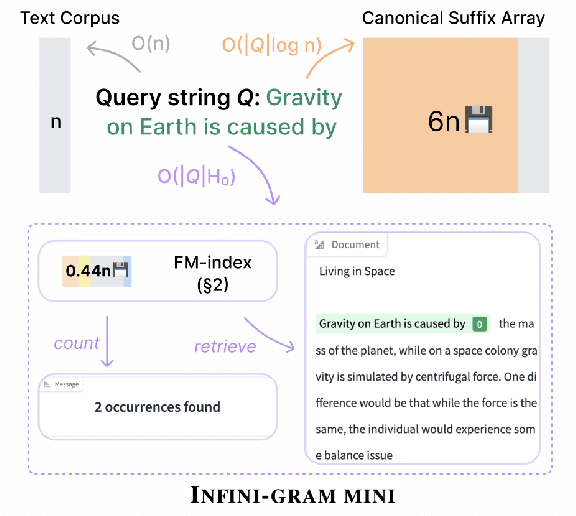
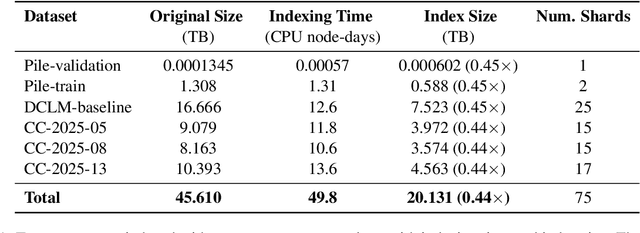
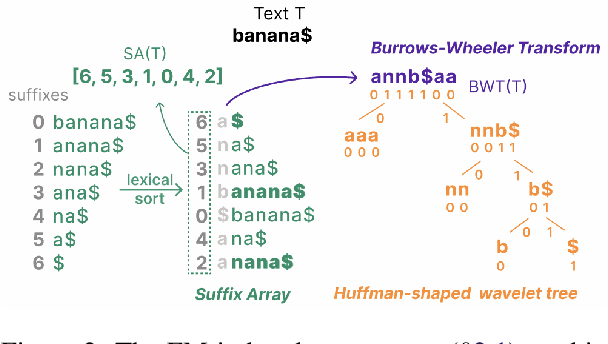
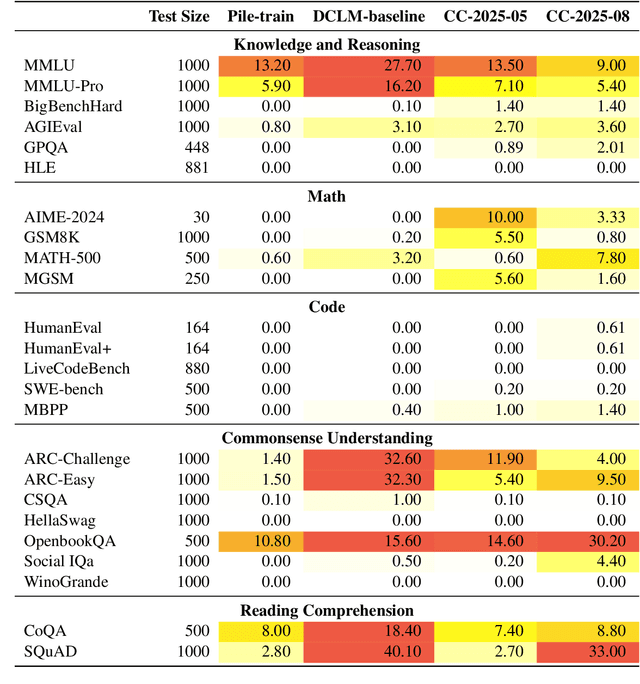
Abstract:Language models are trained mainly on massive text data from the Internet, and it becomes increasingly important to understand this data source. Exact-match search engines enable searching in large text corpora -- counting string appearances and retrieving the enclosing documents -- yet the high storage overhead hinders their application on Internet-scale data. We present Infini-gram mini, an efficient and scalable system that can make petabyte-level text corpora searchable. Based on the FM-index data structure (Ferragina and Manzini, 2000), which simultaneously indexes and compresses text, our system creates indexes with size only 44% of the corpus. Infini-gram mini greatly improves upon the best existing implementation of FM-index in terms of indexing speed (18$\times$) and memory use during both indexing (3.2$\times$ reduction) and querying (down to a negligible amount). We index 46TB of Internet text in 50 days with a single 128-core CPU node (or 19 hours if using 75 such nodes). We show one important use case of Infini-gram mini in a large-scale analysis of benchmark contamination. We find several core LM evaluation benchmarks to be heavily contaminated in Internet crawls (up to 40% in SQuAD), which could lead to overestimating the capabilities of language models if trained on such data. We host a benchmark contamination bulletin to share the contamination rate of many core and community-contributed benchmarks. We also release a web interface and an API endpoint to serve general search queries on Infini-gram mini indexes.
FinanceReasoning: Benchmarking Financial Numerical Reasoning More Credible, Comprehensive and Challenging
Jun 06, 2025Abstract:We introduce FinanceReasoning, a novel benchmark designed to evaluate the reasoning capabilities of large reasoning models (LRMs) in financial numerical reasoning problems. Compared to existing benchmarks, our work provides three key advancements. (1) Credibility: We update 15.6% of the questions from four public datasets, annotating 908 new questions with detailed Python solutions and rigorously refining evaluation standards. This enables an accurate assessment of the reasoning improvements of LRMs. (2) Comprehensiveness: FinanceReasoning covers 67.8% of financial concepts and formulas, significantly surpassing existing datasets. Additionally, we construct 3,133 Python-formatted functions, which enhances LRMs' financial reasoning capabilities through refined knowledge (e.g., 83.2% $\rightarrow$ 91.6% for GPT-4o). (3) Challenge: Models are required to apply multiple financial formulas for precise numerical reasoning on 238 Hard problems. The best-performing model (i.e., OpenAI o1 with PoT) achieves 89.1% accuracy, yet LRMs still face challenges in numerical precision. We demonstrate that combining Reasoner and Programmer models can effectively enhance LRMs' performance (e.g., 83.2% $\rightarrow$ 87.8% for DeepSeek-R1). Our work paves the way for future research on evaluating and improving LRMs in domain-specific complex reasoning tasks.
Open CaptchaWorld: A Comprehensive Web-based Platform for Testing and Benchmarking Multimodal LLM Agents
May 30, 2025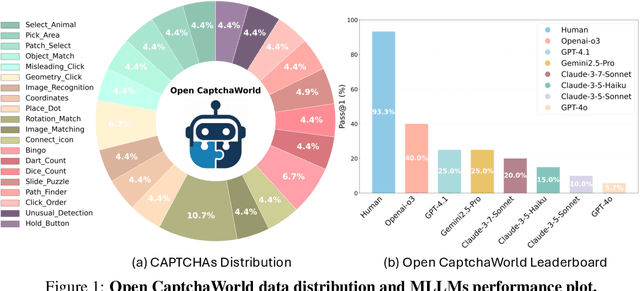
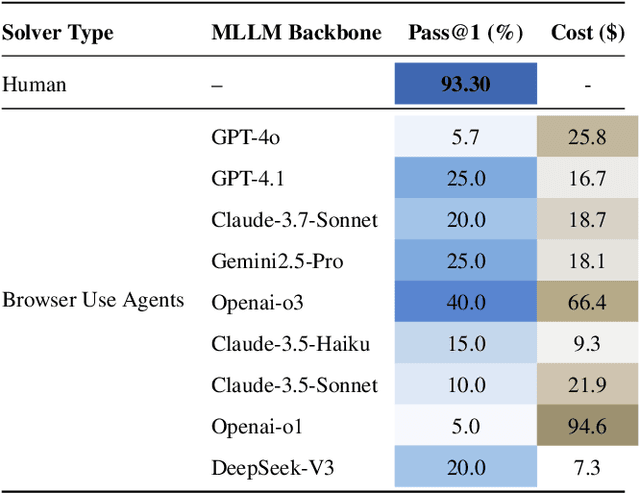
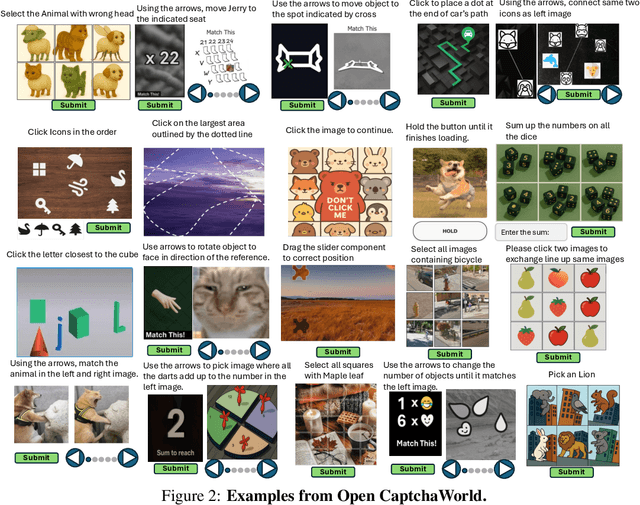
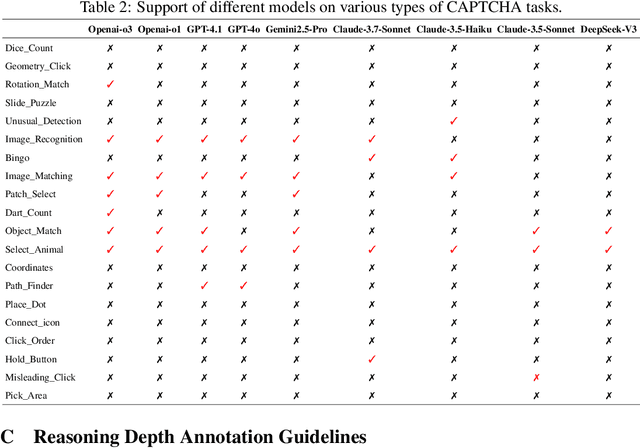
Abstract:CAPTCHAs have been a critical bottleneck for deploying web agents in real-world applications, often blocking them from completing end-to-end automation tasks. While modern multimodal LLM agents have demonstrated impressive performance in static perception tasks, their ability to handle interactive, multi-step reasoning challenges like CAPTCHAs is largely untested. To address this gap, we introduce Open CaptchaWorld, the first web-based benchmark and platform specifically designed to evaluate the visual reasoning and interaction capabilities of MLLM-powered agents through diverse and dynamic CAPTCHA puzzles. Our benchmark spans 20 modern CAPTCHA types, totaling 225 CAPTCHAs, annotated with a new metric we propose: CAPTCHA Reasoning Depth, which quantifies the number of cognitive and motor steps required to solve each puzzle. Experimental results show that humans consistently achieve near-perfect scores, state-of-the-art MLLM agents struggle significantly, with success rates at most 40.0% by Browser-Use Openai-o3, far below human-level performance, 93.3%. This highlights Open CaptchaWorld as a vital benchmark for diagnosing the limits of current multimodal agents and guiding the development of more robust multimodal reasoning systems. Code and Data are available at this https URL.
 Add to Chrome
Add to Chrome Add to Firefox
Add to Firefox Add to Edge
Add to Edge